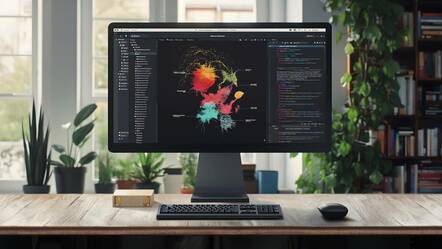Nvidia shrinks Grace-Blackwell Superchip to power $3K mini PC
Tuned for running chunky models on the desktop with 128GB of RAM, custom Ubuntu
CES Nvidia has announced a desktop computer powered by a new GB10 Grace-Blackwell superchip and equipped with 128GB of memory to give AI developers, researchers, and students the tools they need to run large models on the desktop.
Code-named Project Digits and announced at the annual CES super-event in Las Vegas today, the $3,000 system was developed in collaboration with MediaTek, and is powered by an Arm-based Grace CPU and Blackwell GPU that, based on renders released by Nvidia, appear to reside in a single SoC. The box will ship with a special brew of Ubuntu Linux pre-configured to take advantage of the hardware.
Project Digits vaguely resembles an Intel NUC mini-PC in terms of size. Nvidia hasn’t detailed the GB10’s specs in full but has said the machine it powers delivers a full petaFLOP of AI performance. But before you get too excited about the prospect of a small form factor desktop outperforming Nvidia’s A100 tensor core GPU, know that the machine’s performance was measured on sparse 4-bit floating point workloads.
Specs we’ve seen suggest the GB10 features a 20-core Grace CPU and a GPU that packs manages a 40th the performance of the twin Blackwell GPUs used in Nvidia’s GB200 AI server.

Nvidia's $3,000 Project Digits promises to cram 1PF of FP4 compute into a tiny mini PC smaller than your coffee mug ... Click to enlarge. Source: Nvidia
The machine nonetheless packs rather more power than an AI PC powered by processors from Intel, AMD, or Qualcomm, but will struggle to compete with a workstation packing Nvidia's current flagship workstation card, the RTX 6000 Ada. That accelerator boasts 1.45 petaFLOPS of sparse FP/INT8 performance, roughly triple the performance we think Project Digits will deliver (500 teraFLOPS) at that precision.
Feeding those flops are 128GB of LPDDR5x memory. According to Allen Bourgoyne, Nvidia’s director of product marketing for enterprise platforms, the decision to equip the system with this much memory was intentional to make working with large AI models more accessible.
Nvidia claims Project Digits will be able to support models up to 200 billion parameters in size. However, to fit such models into the machine they will need to be compressed to 4-bits, a concept you can learn more about in our hands-on guide.
Running larger models will be possible thanks to onboard ConnectX networking that Nvidia says will allow two of these computers to be connected so they can run models with up to 405 billion parameters. That puts Meta's Llama 3.1 405B in play, again at 4-bits.
For reference, if you wanted to run that same model at 4-bits on existing workstation hardware you'd need at least five 48GB GPUs.
It’s unclear how Project Digits will perform when running such models, as at the time of writing Nvidia hadn't disclosed memory bandwidth, a key metric for inference performance of large language models.
From the renders shown to the press prior to the Monday night CES keynote at which Nvidia announced the box, the system appeared to feature six LPDDR5x modules. Assuming memory speeds of 8,800 MT/s we'd be looking at around 825GB/s of bandwidth which wouldn't be that far off from the 960GB/s of the RTX 6000 Ada. For a 200 billion parameter model, that'd work out to around eight tokens/sec. Again, that's just speculation, as the full spec-sheet for the system wasn't available prior to CEO Jensen Huang's CES Keynote.
Along with AI inferencing, Nvidia also expects Project Digits will be well suited to model experimentation, fine tuning, data science, and other edge applications.
Along with an ample supply of memory, Project Digits will come equipped with 4TB of NVMe storage, which should be plenty for most open models, especially those that have been quantized down to 4-bits.
Customers can expect to get their hands on a table-top superchip beginning in May though, as we mentioned earlier it won't come cheap, with systems starting at $3,000.
- MediaTek rings in the new year with a parade of chipset vulns
- AI spending spree continues as Microsoft commits $80B for 2025
- AI's rising tide lifts all chips as AMD Instinct, cloudy silicon vie for a slice of Nvidia's pie
- Nvidia upgrades tiny Jetson Orin Nano dev kits for the holidays
Nvidia the PC player? Yeah, nah
Project Digits is not Nvidia’s first foray onto the desktop. The GPU giant has offered its Jetson dev kits for years and debuted a new model – the Orin Nano Super – in December 2024.
The new machine is essentially just a grown-up Jetson with a whole lot more computational grunt.
Nvidia hasn't said whether it'll offer the GB10 to other PC makers – a tantalizing prospect that would shake up the market.
In its current form, this machine looks more like it is aimed at getting folks comfortable with Nvidia's more powerful Grace-Blackwell Superchips like the GB200 and GB200 NVL4 we've looked at previously.
The reason for this is simple: the Arm Neoverse V2 cores used in Nvidia's Grace CPUs thus far were announced more than two years ago and were engineered with datacenter workloads in mind.
That's not to say Nvidia won’t one day market the GB10 for gaming and graphics centric products, like the company has already done with its Tegra line of SoCs. If the GB10 is using a more modern CPU core than the original Grace CPU, it certainly wouldn't be out of the realm of possibility. ®
 Biting the hand that feeds IT
Biting the hand that feeds IT